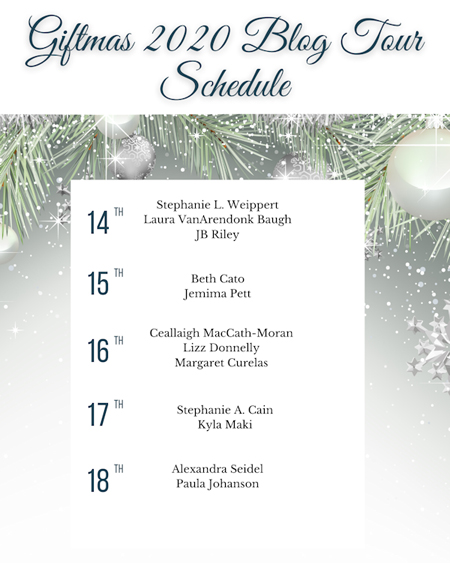Bready or Not: Galette Des Rois
Eat like royalty without a lot of fuss with this shortcut recipe for Galette Des Rois!
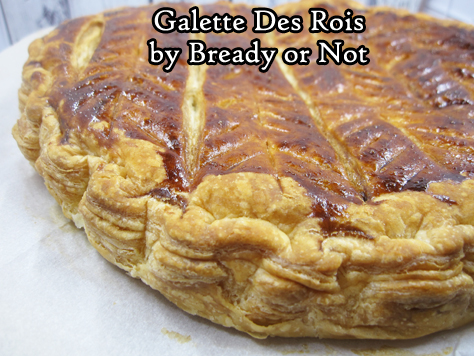
Galette des Rois (King Cake) celebrates Epiphany and is available throughout January in France.
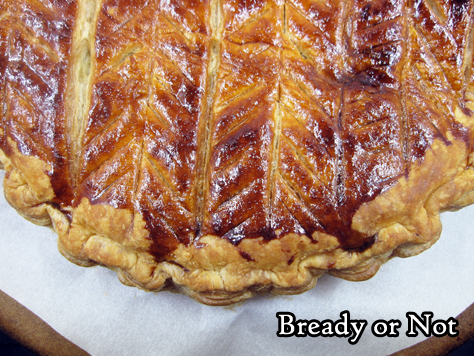
I am so not in France. Nor did I get to go there in June, as planned. Sigh. So, I have to make-do.
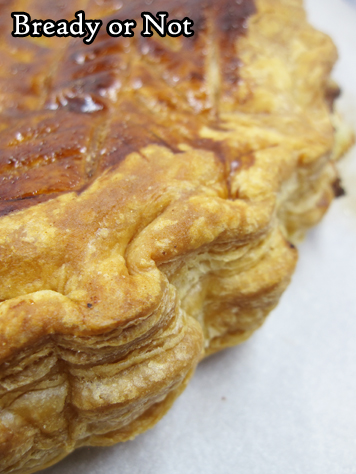
However, making-do can still be delicious. Frozen puff pastry is great stuff. You make a frangipane from scratch, but it’s pretty straightforward.
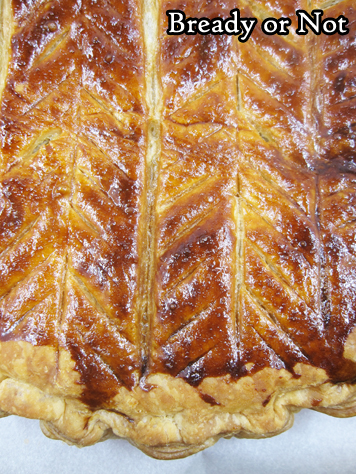
Honestly, the trickiest part for me was figuring out what pattern to etch into the top of the galette–and then hope that I didn’t dig the knife in too deeply.
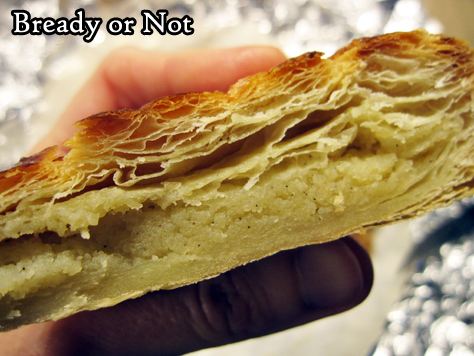
If you do a Google search for Galette des Rois, you’ll see all sorts of different patterns you can do. I’m happy with my choice. And that I didn’t cut too deeply.
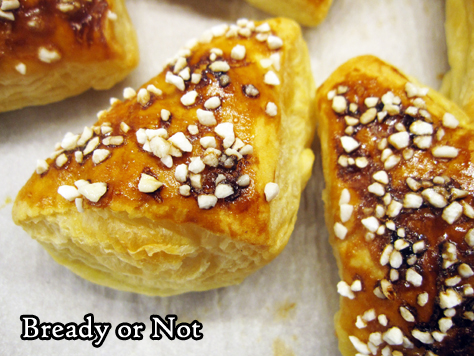
Because I am OCD and can’t bear to waste food, I include a bonus recipe on a great way to bake-up the scraps of puff pastry, too.
The galette and scraps are tastiest the day they are baked, but they are still good for the next few days, too.
Adapted from Dorie Greenspan.
Bready or Not: Galette Des Rois
Equipment
- baking sheet
- parchment paper
- pastry brush
Ingredients
Frangipane filling
- 6 Tablespoons unsalted butter room temperature
- 3/4 cup confectioners’ sugar
- 3/4 cup almond flour sifted
- 1/4 teaspoon salt
- 2 large eggs room temperature
- 1 Tablespoon rum optional but awesome
- 1 teaspoon vanilla extract or vanilla bean paste
Cake
- 1 puff pastry dough box 14-17 ounce package, cold
- 1 whole almond for the traditional charm
Instructions
Prepare the frangipane
- This can be made up to a day ahead, but needs at least an hour to chill before assembling the galette.
- Beat together the butter and sugar until they are creamy and light. Add the almond flour and salt. Add one whole egg. Divide the other egg, adding only the white–reserve the yolk for later. Mix in the rum, if using, and the vanilla extract.
- Transfer to a small bowl. Cover with plastic wrap, pressing it against the top of the mix, then place in fridge to chill.
- Mix the reserved yolk with 1 teaspoon of cold water, and cover it and set it in the fridge as well.
Assembling the galette
- Set out a complete sheet of puff pastry. Cut a 9-1/2 diameter circle out of the middle; if a 9-inch tart pan insert is available, use that as a handy guide. Set aside scraps from edges. Place the cut round on a parchment-lined baking sheet.
- Repeat the process with the second sheet of puff pastry. Place all of the cut-off bits aside in the fridge for now.
- Return to the pastry round on the baking sheet. Spread the frangipane evenly over the dough, but leave a 1-inch border bare. Place the almond somewhere on the filling. Moisten the border with some cold water. Set the second round of pastry on top and press it down around the edges to seal them together.
- Use the back of a butter knife to scallop the edges by creating an indentation about a quarter-inch deep, spaced out about a half-inch apart. Refrigerate for about 30 minutes.
- Preheat the oven at 425-degrees.
- Pull out the chilled galette. Brush a thin layer of yolk over the top, but be very careful that it doesn’t drip down over the edge, or the galette won’t rise. Use a paring knife to etch a design on the very top of the galette while taking care not to cut too deeply. Add 6 small slits spaced out to act as steam vents.
- Drop the oven temperature to 400-degrees. Bake the galette for 30 to 40 minutes, until it is puffed and golden brown. Keep an eye on it. If filling starts to ooze out, scrape it away so that it doesn’t drip off the pan. If the galette is browning too fast, cover it with aluminum foil.
- Transfer it to a rack to cool for at least 15 minutes. Expect it to deflate some, as that is the way of puff pastry. Best eaten when fresh, served warm or at room temperature, but can be chilled and eaten over the coming days.
- Bonus: As soon as the galette is out of the oven, put the puff pastry scraps on the parchment. Brush the remaining yolk atop. Then add a topping like pearl sugar, turbinado sugar, or maple sugar. Bake scraps for 15 to 20 minutes, until pieces are puffed and golden. Like the galette, they are best eaten the same day, but are still quite edible after that.
OM NOM NOM!
Bready or Not: Cheese and Chives Yorkshire Puddings (Small Batch)
Yorkshire puddings are what many Americans also know of as popovers–light, airy, crisp sponges perfect to eat with a roast and gravy!
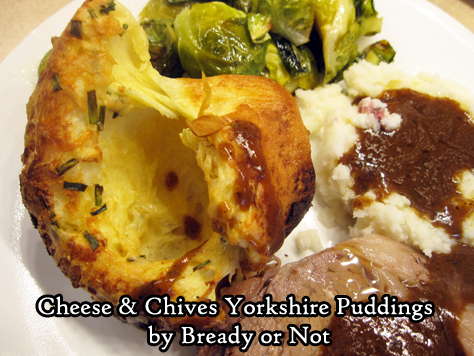
This recipe is for a small batch of puds. Since they are so airy (if they rise right), the six puddings of this recipe are perfect for two or three people.
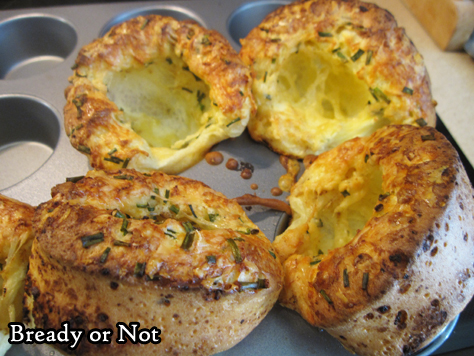
Cheese makes everything better, of course. I used Dubliner Irish Cheddar, as it is available at my nearest Costcos for a good price.
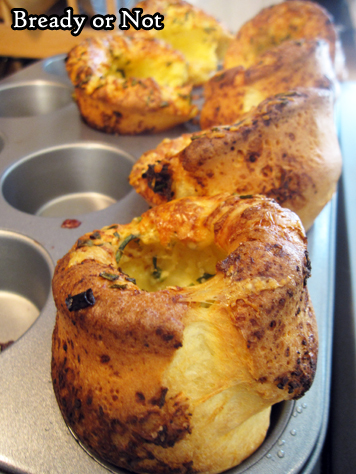
Use a good quality cheddar here to really take these puddings to the next level.
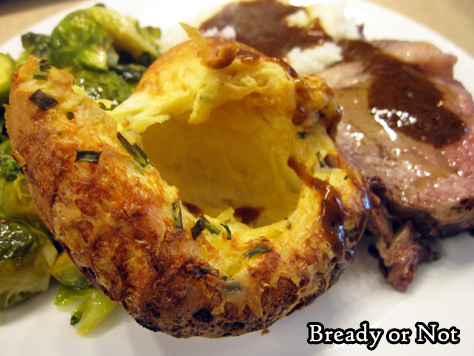
Modified from Bake from Scratch Magazine.
Bready or Not: Cheese and Chives Yorkshire Puddings (Small Batch)
Equipment
- metal muffin pan
- blender
Ingredients
- 3/4 cup milk or half & half
- 2 large eggs room temperature
- 3 Tablespoons unsalted butter melted, divided
- 3/4 cup all-purpose flour
- 1/2 teaspoon kosher salt
- 1/4 cup quality cheddar cheese (25 grams), freshly grated
- 1 1/2 Tablespoons fresh chives chopped, plus more for garnish
Instructions
- Preheat oven at 425-degrees.
- In the container of a blender, place milk, eggs, 1 tablespoon melted butter, flour, and salt; process just until smooth. Let rest for 10 minutes.
- In a small bowl, toss together grated cheese and chives.
- Place a 12-cup muffin pan in oven for 5 minutes to preheat.
- Remove muffin pan from oven, and quickly spoon the remaining 2 tablespoons melted butter into the 6 muffin cups that are being used. Return pan to oven for 2 minutes.
- Remove pan from oven. Working fast, spoon or pour batter into buttered muffin cups, dividing as evenly as possible. Top each with a spoonful of cheese mixture.
- Bake until puffed and golden brown, 15 to 18 minutes. Garnish with more chives, if desired. Serve immediately. Yorkshires are best fresh as they deflate after baking.
OM NOM NOM!
Bready or Not: Lebkuchen
It’s my understanding that there are likely thousands of Lebkuchen recipes in the world, and here is mine.
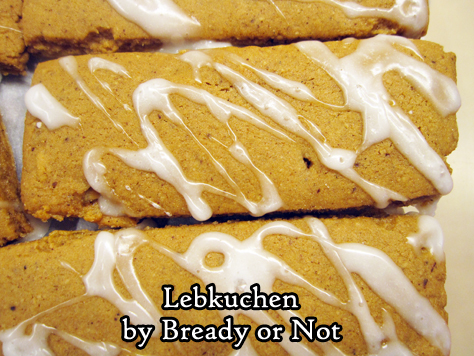
This traditional German Christmas cookie is like a gingerbread cookie, but is a lot more complex due to the spices used and the citrus mixed in.
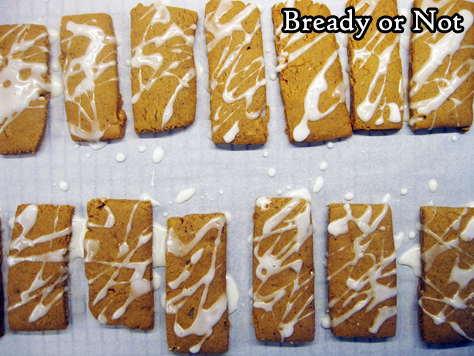
Even the glaze adds to that wonderfully fresh citrus flavor, as it has a bit of lemon juice mixed in.
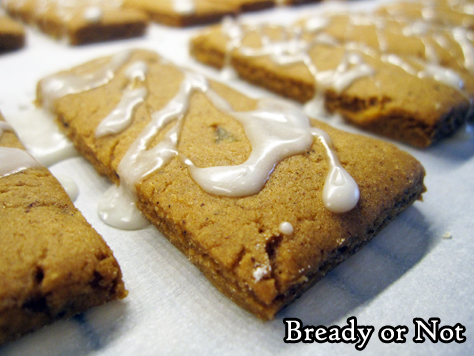
The only somewhat odd ingredient is chopped-up candied orange. I actually cut up a whole-slice version that Trader Joe’s sells at the holidays, but otherwise candied orange should be found near fruitcake ingredients at many grocery stores.
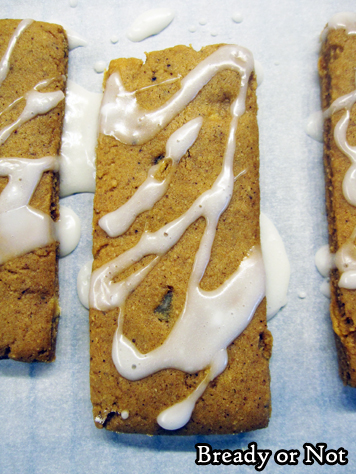
Note that this cookie dough needs to chill for a full day. That gives the flour time to develop and for the spices to really do their thing.
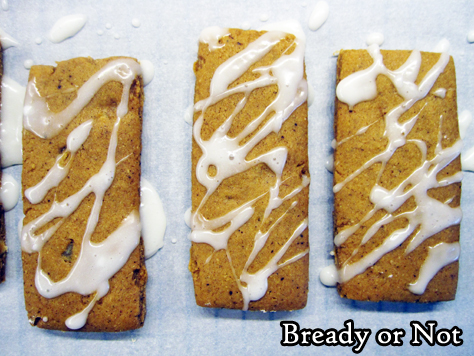
And trust me, you want their thing done. These are awesome cookies, sure to delight and surprise anyone who digs in.
Modified from a recipe printed in Cooking Light Magazine, December 2008.
Bready or Not: Lebkuchen
Ingredients
Cookies
- 3/4 cup brown sugar packed
- 1/2 cup honey
- 1/4 cup unsalted butter half stick
- 1/4 cup dark molasses
- 2 teaspoons espresso powder
- 1 large egg
- 3/4 cup ground almonds sifted
- 1/2 cup candied orange slices chopped, or candied orange peel
- 3 1/2 cups all-purpose flour 15.75 ounces
- 1 teaspoon ground cinnamon
- 1/2 teaspoon baking soda
- 1/2 teaspoon ground cardamom
- 1/2 teaspoon ground cloves
- 1/4 teaspoon ginger
- 1/8 teaspoon salt
Glaze
- 3/4 cup confectioners’ sugar
- 2 teaspoons lemon juice
- 1 1/2 teaspoons water
Instructions
- In a medium saucepan on medium heat, constantly stir together the brown sugar, honey, butter, and molasses until the sugar is dissolved. Make sure it doesn’t come to a boil. Transfer the mixture to large bowl and let it cool to room temperature.
- Add the espresso powder and egg to the cool sugar mixture. Follow that up with the ground almonds and candied orange bits.
- In a separate bowl, stir together the rest of the dry ingredients. Gradually combine the two bowls until just mixed. Lift it up and knead it for a minute or so to make sure no flour remains at the bottom.
- Wrap dough in plastic wrap and stash in the fridge for at least a day.
- Preheat oven at 325-degrees. Cover two large baking sheets with parchment paper.
- Divide dough into 4 portions. Keep the other portions chilled while rolling 1 out into a 8×6-inch rectangle. Cut (a pizza slicer or bench knife are great) into 3×1-inch bars. Transfer to baking sheet, setting them an inch apart.
- Bake for about 20 minutes, or until firm. If cooking both sheets at once, switch their positions about halfway through.
- As soon as the cookies are out, mix up the glaze. Drizzle glaze back and forth over the warm cookies. Let glaze set for an hour before packing up cookies in sealed containers.
OM NOM NOM!
Giftmas 2020: Help the Edmonton Food Bank!

I’m taking part in Giftmas again this year, an annual effort coordinated by Rhonda Parrish for the benefit of the Edmonton Food Bank. I don’t need to state the reasons why helping food banks is more important this year than ever before. We need to help each other. We can’t connect in person, but we can connect with a few bucks that will help fill bellies and add warmth to the world through kindness. If you’re American like me, your dollars will deliver extra bang with each buck, too. $1 = 3 meals.
Rhonda asked Giftmas participants to post on the subject of connections. For me, this year has featured an evolving connection with my son.
He turned fifteen in March. We didn’t get to do his annual birthday trip to IKEA, where he loves following the handout map and the big arrows on the floor, as he has since he was a preschooler. He’s autistic. He loves maps and numbers, and IKEA is all about those things.
Last year, he started high school. It was not a transition without hiccups. He needs routine and quiet. He struggles to understood the chaos of other people. The lead-in to his birthday was the start of virtual high school. It was… tumultuous, to say the least. The kid who needs routine, losing all semblance of it. Me, I’m diagnosed OCD and not much better at handling this stuff than he is, but I have to be the cool-headed parent because if I crack, he will really crack.
I’m also the at-home parent as I do this writer thing. I was the one who had to talk him through the fear, the unknowns. I had to talk myself through, too.
As April chugged along, as masks became the thing, his school days began to find more of a groove. He did, too. He actually found it easier to focus on his work in the online school format. I enjoyed having him around, too, preparing lunch for him and checking in during breaks to see how things were going. It became a situation that bonded us more, as we talked at lunch about the new COVID-19 case numbers for the day and what they meant for our family.
We’ve continued to work through, day by day, as his sophomore year began in the fall. He started out online, then got to return to school for two days a week for three weeks before an outbreak shut his school down in early November. Soon after that, rising case numbers for Arizona forced his entire district to return to online learning to finish out 2020. He’s handled these transitions oddly well. I’m proud of him. This year has been hard, but he has grown in this time. So have I.
That said, I selfishly would like fewer growth-through-adversity moments in 2021, for our sakes and for everyone else, too.
Thank you.
Follow the entire blog tour through RhondaParrish.com and her social media.
